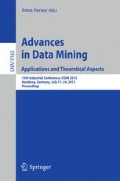Abstract
Customer or market segmentation is an important instrument for the optimisation of marketing strategies and product portfolios. Clustering is a popular data mining technique used to support such segmentation – it groups customers into segments that share certain demographic or behavioural characteristics. In this research, we explore several automatic approaches which support an important task that starts after the actual clustering, namely capturing and labeling the “essence” of segments. We conducted an empirical study by implementing several of these approaches, applying them to a data set of customer representations and studying the way our study participants interacted with the resulting cluster representations. Major goal of the present paper is to find out which approaches exhibit the greatest ease of understanding on the one hand and which of them lead to the most correct interpretation of cluster essence on the other hand. Our results indicate that using a learned decision tree model as a cluster representation provides both good ease of understanding and correctness of drawn conclusions.
Access this chapter
Tax calculation will be finalised at checkout
Purchases are for personal use only
References
Cohen, W.: Fast effective rule induction. In: Proceedings of the Twelfth International Conference on Machine Learning, pp. 115–123 (1995)
Dempster, A., Laird, N., Rubin, D.: Maximum likelihood from incomplete data via the EM algorithm. J. R. Stat. Soc. Ser. B (Methodol.) 39, 1–38 (1977)
Radev, D.R., Jing, H., Stys, M., Tam, D.: Centroid-based summarization of multiple documents. Inf. Process. Manage. 40(6), 919–938 (2004)
Fisher, D.: Knowledge acquisition via incremental conceptual clustering. Mach. Learn. 2(2), 139–172 (1987)
Gordon, A.: Classification, 2nd edn. Taylor and Francis, London (1999)
Huang, Z.: Clustering large data sets with mixed numeric and categorical values. In: Proceedings of the First Pacific-Asia Conference on Knowledge Discovery and Data Mining, pp. 21–34 (1997)
Jain, A.K.: Data clustering: 50 years beyond K-means. Pattern Recogn. Lett. 31(8), 651–666 (2010)
Kotsiantis, S.: Supervised machine learning: a review of classification techniques. Informatica 31(3), 249–268 (2007)
MacQueen, J.: Some methods for classification and analysis of multivariate observations. In: Proceedings of the Fifth Berkeley Symposium on Mathematical Statistics and Probability, vol. 1, pp. 281–297 (1967)
Popescul, A., Ungar, L.: Automatic labeling of document clusters (2000), http://citeseer.nj.nec.com/popescul00automatic.html
Quinlan, R.: C4.5: Programs for Machine Learning. Morgan Kaufmann Publishers, San Mateo (1993)
Saglam, B., Salman, F., Sayin, S., Trkay, M.: A mixed-integer programming approach to the clustering problem with an application in customer segmentation. Eur. J. Oper. Res. 173(3), 866–879 (2006)
Teichert, T., Shehu, E., von Wartburg, I.: Customer segmentation revisited: The case of the airline industry. Transp. Res. Part A: Policy Pract. 42(1), 227–242 (2008)
Treeratpituk, P., Callan, J.: Automatically labeling hierarchical clusters. In: Proceedings of the 2006 International Conference on Digital Government Research, pp. 167–176 (2006)
Weber, R.: Customer segmentation for banks and insurance groups with fuzzy clustering techniques. In: Fuzzy Logic, pp. 187–196 (1996)
Wedel, M., Kamakura, W.: Market Segmentation: Conceptual and Methodological Foundations, 2nd edn. Kluwer Academic Publishers, Boston (2000)
Author information
Authors and Affiliations
Corresponding author
Editor information
Editors and Affiliations
Rights and permissions
Copyright information
© 2015 Springer International Publishing Switzerland
About this paper
Cite this paper
Witschel, H.F., Loo, S., Riesen, K. (2015). How to Support Customer Segmentation with Useful Cluster Descriptions. In: Perner, P. (eds) Advances in Data Mining: Applications and Theoretical Aspects. ICDM 2015. Lecture Notes in Computer Science(), vol 9165. Springer, Cham. https://doi.org/10.1007/978-3-319-20910-4_2
Download citation
DOI: https://doi.org/10.1007/978-3-319-20910-4_2
Published:
Publisher Name: Springer, Cham
Print ISBN: 978-3-319-20909-8
Online ISBN: 978-3-319-20910-4
eBook Packages: Computer ScienceComputer Science (R0)

